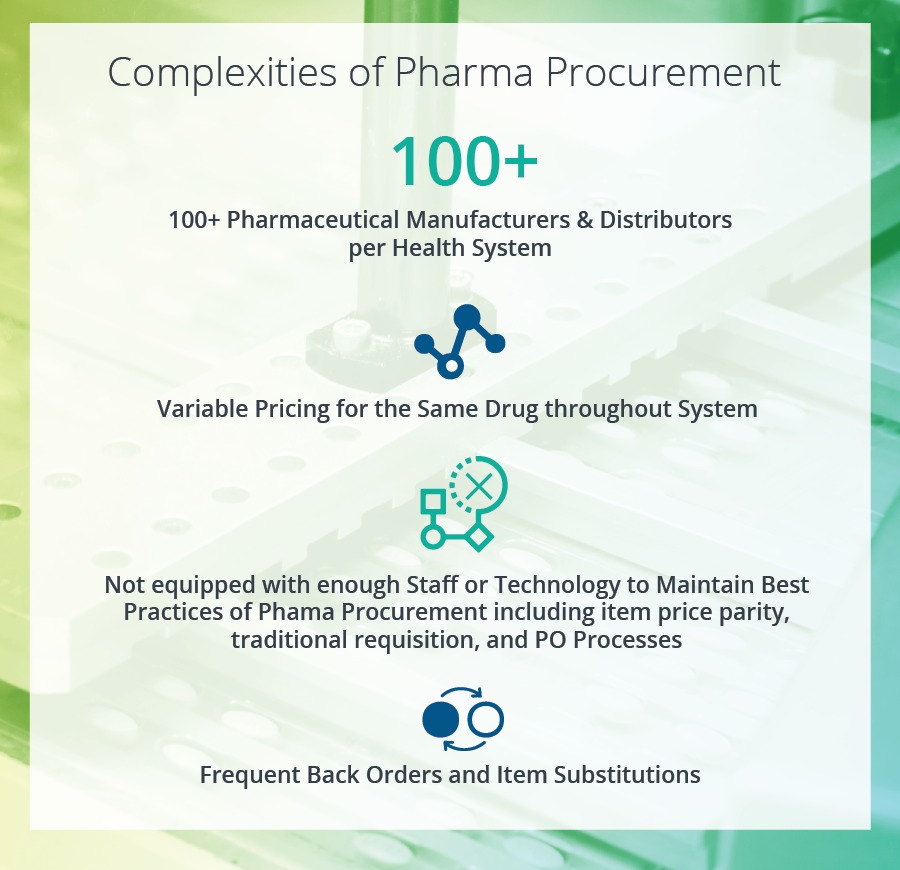
A Letter from TAG CEO, John Weiss
January 20, 2022
5 Areas for Health Systems to Implement Supply Chain Automation
April 27, 2022The Challenges of Pharmaceutical Procurement
Managing the pharmaceutical procurement process for a large health system is a complex and grueling process. Why? Because it is commonplace for these organizations to purchase from multiple manufacturers and distributors - resulting in excess of 100 accounts.
With so many pharmaceutical accounts to manage, it becomes difficult to know whether health systems continue to get the correct or best price. For example, during the course of a year, a health system paid nine different prices for Astra Zeneca’s drug Symbicort ranging anywhere from $0.05 to $232.

Most health systems are not equipped with the capabilities to properly and effectively manage drug procurement. It is often not operationally feasible to properly maintain pharmaceutical item prices, related traditional requisition, and Purchase Order (PO) processes.
Pharma procurement is further compounded by frequent back orders and item substitutions making it even more of a headache to use the traditional day-to-day PO process historically used for the purchase of medical supplies.
As a result, health systems rely on their pharmacy distributors to manage the pricing of their pharmaceuticals and trust that they are invoicing correctly. While this approach provides convenience, periodic reviews of item pricing and invoicing must be done. This ensures health systems are not over-paying and are realizing the promised savings from drug manufacturers and distributors.
Why is there Variable Pricing for Pharmaceuticals?
Variable pricing for pharmaceuticals stems from many issues. One of the main issues is the account Class of Trade (COT). An account’s COT is determined by the nature and care being provided for a particular account or entity.
Class of Trade (COT) is simple to identify in a general way, but complicated in its use in contracts, marketing programs, and—most significantly—how pricing data are reported to the federal government.
Examples of COTs
- Ambulatory Surgery Center
- Retail pharmacies
- Hospital
- Long Term Care Facilities
- Infusion Centers
- Imaging Centers
- Closed Door Pharmacies
- Physician Practices
Discount Programs Complicate Pharma Pricing Management
While manufacturers typically set pricing based on an account assigned COT, the pricing is further complicated by federal programs. These programs such as the 340B Drug Pricing Program offer further pricing discounts based on the economic status of the patient, demographics of the surrounding community, and inpatient or outpatient use.
Most Common Scenarios of Variant Drug Pricing
340B Drug Pricing Program
The 340B federal program enables eligible CEs to receive heavily discounted pricing on certain drugs serving an indigent population in an outpatient setting. If a hospital meets the required eligibility, it is considered a covered entity (CE) and can access the steeply discounted prices for eligible products on what is known as 340B or Public Health Service (PHS) contracts. This pricing typically adjusts every 90 days. For example, Eli Lily’s Humulin product was a 340B eligible item in 2021 which changed prices four times from $10.54, $10.57, $11.76, and $11.80.
340B and Disproportionate Share Hospitals (DSH)
340B and the DSH program is a complex discounted pricing program similar to the 340B drug program but in an inpatient setting.
Further 340B Pricing Complications
Hospitals can also apply for 340B designations without meeting the indigent population requirement, should they be eligible. Some of the alternate designations are:
- Rural Referral Centers
- Sole Community Hospitals
- Critical Access Hospital
- Free-Standing Cancer Hospital
Hospitals with these designations are not eligible for the full catalog of the drugs covered in the 340B program. There are certain drugs covered in the Orphan Drug Program where manufacturers are not required to extend the discounted 340B pricing.
COG & COT in Health System’s Pharma Procurement
Distributors frequently include a cost of good (COG) discount or premium depending upon their COT. The COG discount is a reduction of the price by a pre-negotiated percentage, whereas a premium is the addition of a pre-negotiated percentage.
The majority of a health system’s purchases will be subject to a COG discount. However, if the drug is purchased by a non-acute entity, such as a physician practice or infusion center, it is not uncommon for the distributor to charge a COG premium, wadding to the cost of the drug. Further, many larger drug manufacturers will reduce the COG discount on expensive cancer or biological drugs. The same item can now have multiple COG discounts or premiums, determined by the entity making the purchase.
Pharmaceutical Procurement Volume Varients
Considering the high volume of purchases, monitoring and ensuring the correct price point at the time of invoicing is a massive undertaking. Health systems rely on their distributors to work with manufacturers and Group Purchasing Organizations (GPOs) to maintain the proper pricing of their items. This includes relying on distributors to issue credit when incorrect prices are identified. Distributors do a decent job of managing their client’s prices, but financially significant errors still occur. This most frequently occurs in instances where a 340B eligible or CE receives list price instead of their eligible 340B price. These price swings can be in excess of 1000%. Pricing issues can easily approach $1,000,000+ in overcharges if not addressed promptly.
Pharma Procurement Approvals
Many manufacturers have unilateral policies where pricing errors must be identified during their approved window. This window may be as short as 30 days from invoicing. If the error is found outside the window, the manufacturer and distributor will not issue the credit for their error.
Drug Pricing Reporting and Review
In order to prevent financial loss, it is important to review all price changes with regularity as mentioned below. Distributors can provide price change reports by account and item. These reports allow health systems to quickly identify large price increases and assess accuracy.
Reviewing this report as frequently as bi-weekly allows for any errors to be corrected before getting out of hand, or out of the manufacturer’s narrow review timeframe. On a quarterly basis, all of the health system's purchases should be matched to any available GPO or local contracts to ensure the correct prices were received over the previous 90 days.
Perhaps more easily, compare all accounts with the same COT and consistent pricing to catch similarities between accounts. It is not uncommon for a manufacturer to extend a courtesy contract to one account, but not another similar account. All instances where similar accounts are not receiving the same pricing must be discussed with the distributor/manufacturer to align the pricing across the system.
Health systems must be proactive in reviewing their prices and historical invoices for errors. While the distributor is likely catching errors, health systems cannot expect that they are catching all errors. Procurement must also remember that all distributors do not always have the organization’s best interest in mind.



